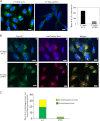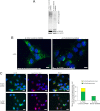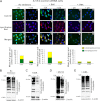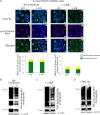ISG15 deregulates autophagy in genotoxin-treated ataxia telangiectasia cells
- PMID: 23212917
- PMCID: PMC3554909
- DOI: 10.1074/jbc.M112.403832
ISG15 deregulates autophagy in genotoxin-treated ataxia telangiectasia cells
Abstract
Ataxia-telangiectasia (A-T) is a cerebellar neurodegenerative disorder; however, the basis for the neurodegeneration in A-T is not well established. Lesions in the ubiquitin and autophagy pathways are speculated to contribute to the neurodegeneration in other neurological diseases and may have a role in A-T neurodegeneration. Our recent studies revealed that the constitutively elevated ISG15 pathway impairs targeted proteasome-mediated protein degradation in A-T cells. Here, we demonstrate that the basal autophagy pathway is activated in the ubiquitin pathway-compromised A-T cells. We also show that genotoxic stress triggers aberrant degradation of the proteasome and autophagy substrates (autophagic flux) in A-T cells. Inhibition of autophagy at an early stage using 3-methyladenine blocked UV-induced autophagic flux in A-T cells. On the other hand, bafilomycin A1, which inhibits autophagy at a late stage, failed to block UV-induced autophagic flux, suggesting that overinduction of autophagy may underlie aberrant autophagic flux in A-T cells. The ISG15-specific shRNA that restored proteasome function restores autophagic function in A-T cells. These findings suggest that autophagy compensates for the ISG15-dependent ablation of proteasome-mediated protein degradation in A-T cells. Genotoxic stress overactivates this compensatory mechanism, triggering aberrant autophagic flux in A-T cells. Supporting the model, we show that autophagy is activated in the brain tissues of human A-T patients. This highlights a plausible causal contribution of a novel "ISG15 proteinopathy" in A-T neuronal cell death.
Figures









Similar articles
-
Evidence for the Deregulation of Protein Turnover Pathways in Atm-Deficient Mouse Cerebellum: An Organotypic Study.J Neuropathol Exp Neurol. 2017 Jul 1;76(7):578-584. doi: 10.1093/jnen/nlx038. J Neuropathol Exp Neurol. 2017. PMID: 28535250
-
ISG15 attenuates post-translational modifications of mitofusins and congression of damaged mitochondria in Ataxia Telangiectasia cells.Biochim Biophys Acta Mol Basis Dis. 2021 Jun 1;1867(6):166102. doi: 10.1016/j.bbadis.2021.166102. Epub 2021 Feb 19. Biochim Biophys Acta Mol Basis Dis. 2021. PMID: 33617986
-
A novel role for ATM in regulating proteasome-mediated protein degradation through suppression of the ISG15 conjugation pathway.PLoS One. 2011 Jan 26;6(1):e16422. doi: 10.1371/journal.pone.0016422. PLoS One. 2011. PMID: 21298066 Free PMC article.
-
Regulation of mitophagy by the ubiquitin pathway in neurodegenerative diseases.Exp Biol Med (Maywood). 2018 Mar;243(6):554-562. doi: 10.1177/1535370217752351. Epub 2018 Jan 9. Exp Biol Med (Maywood). 2018. PMID: 29316798 Free PMC article. Review.
-
ISG15 in cancer: Beyond ubiquitin-like protein.Cancer Lett. 2018 Dec 1;438:52-62. doi: 10.1016/j.canlet.2018.09.007. Epub 2018 Sep 11. Cancer Lett. 2018. PMID: 30213559 Review.
Cited by
-
ISGylation is induced in neurons by demyelination driving ISG15-dependent microglial activation.J Neuroinflammation. 2022 Oct 20;19(1):258. doi: 10.1186/s12974-022-02618-4. J Neuroinflammation. 2022. PMID: 36261842 Free PMC article.
-
Hydroxycamptothecin mediates antiproliferative effects through apoptosis and autophagy in A549 cells.Oncol Lett. 2018 May;15(5):6322-6328. doi: 10.3892/ol.2018.8107. Epub 2018 Feb 22. Oncol Lett. 2018. PMID: 29616109 Free PMC article.
-
Transcriptomic characterization of tissues from patients and subsequent pathway analyses reveal biological pathways that are implicated in spastic ataxia.Cell Biosci. 2022 Mar 11;12(1):29. doi: 10.1186/s13578-022-00754-1. Cell Biosci. 2022. PMID: 35277195 Free PMC article.
-
Interferon-induced protein ISG15 in the central nervous system, quo vadis?FEBS Lett. 2025 May 12:10.1002/1873-3468.70063. doi: 10.1002/1873-3468.70063. Online ahead of print. FEBS Lett. 2025. PMID: 40353372 Review.
-
LprG-mediated surface expression of lipoarabinomannan is essential for virulence of Mycobacterium tuberculosis.PLoS Pathog. 2014 Sep 18;10(9):e1004376. doi: 10.1371/journal.ppat.1004376. eCollection 2014 Sep. PLoS Pathog. 2014. PMID: 25232742 Free PMC article.
References
-
- Frappart P. O., McKinnon P. J. (2006) Ataxia-telangiectasia and related diseases. Neuromolecular Med. 8, 495–511 - PubMed
-
- Lavin M. F., Khanna K. K. (1999) ATM. The protein encoded by the gene mutated in the radiosensitive syndrome ataxia-telangiectasia. Int. J. Radiat. Biol. 75, 1201–1214 - PubMed
-
- Boder E. (1985) Ataxia-telangiectasia. An overview. Kroc Found. Ser. 19, 1–63 - PubMed
-
- Chun H. H., Gatti R. A. (2004) Ataxia-telangiectasia, an evolving phenotype. DNA Repair 3, 1187–1196 - PubMed
-
- Easton D. F. (1994) Cancer risks in A-T heterozygotes. Int. J. Radiat. Biol. 66, S177–S182 - PubMed
Publication types
MeSH terms
Substances
Grants and funding
LinkOut - more resources
Full Text Sources
Other Literature Sources
Medical
Miscellaneous

